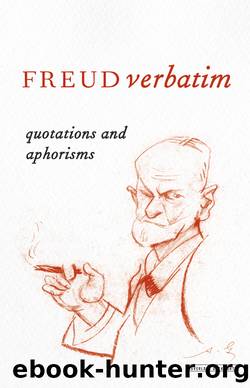Freud Verbatim by Sigmund Freud

Author:Sigmund Freud [ETZLSORFER, HANNES & NOMÄIER, PETER]
Language: eng
Format: epub
Tags: REF018000; PSY000000
ISBN: 9781468311952
Publisher: ABRAMS, Inc. (Ignition)
Published: 2014-11-12T00:00:00+00:00
VI
EROS AND SEXUALITY
ââBeautyâ and âattractivenessâ are originally properties of the sexual object. It is notable that the genitals themselves, the sight of which is always exciting, are hardly ever judged beautiful; on the other hand, the quality of beauty seems to attach to certain secondary sexual characteristics.â
Eros and sexuality occupy a central position in the work of Sigmund Freud. Taking the idea of sexuality as a point of departure, Freudâs analyses went far beyond any conventional narrow definitions, approaching philosophical conceptions of Eros, cultural sexual morality and sexual deviation. Freud recognized the life drive â Eros â as the first and main instinct of human life, and he linked it to self-preservation and the preservation of the species, survival and procreation. He saw the libido as the vital psychical energy of the life drive, which seeks pleasure from the self and others as well as from nonhuman objects. (In psychoanalytic terminology, the word object almost always refers to a person toward whom action or desire is directed.) To describe the focusing of the libido on an object, Freud introduced the concept of Besetzung. In a psychological context, this everyday German word means the âinvestmentâ of psychical energy in an (external) object. For the English versions of his work, Freudâs translators invented the neologism cathexis to translate Besetzung. Here, as in many cases, the translatorsâ turn to Greek (or Latin) has lent Freudâs work an air of esotericism that it lacks in the original German. Within the framework of this âeconomy of the libidoâ, Freud was convinced that inhibition of the sex drive can have grave consequences: âIn addition to all those who are homosexuals by virtue of their organization, or who became so in their childhood, there must be reckoned the great number of those in whom, in their maturer years, a blocking of the main stream of their libido has caused a widening in the side-channel of homosexuality.â
Freud drew key insights regarding the life and death drives â Eros and Thanatos â by comparing and contrasting their individual aspects. Eros generally stands for love and sexual desire. We yearn to unite ourselves with the other. However, this desire to merge into the other is also linked to the danger of destroying the object. Thus the objects that we love and desire are also the ones that we want to destroy. The life drive Eros aims to develop bonds with others, while Thanatos, the death drive, strives to dissolve objects. If a drive is not bound by a moderating psychical agency, either pure destructive rage or pure happiness break through.
In exploring this widely branched complex of themes, Freud pursued two different strategies, which often produced contradictory results. As a physician he focused on the problem by posing strictly scientific questions and by making reference to verified biological and physiological knowledge. As a psychoanalyst, on the other hand, his interest was oriented toward the determining psychical factors of sexuality, whose influence on the psychical development of the individual begins in infancy. Thus Freudian theory puts infantile sexuality, i.
Download
This site does not store any files on its server. We only index and link to content provided by other sites. Please contact the content providers to delete copyright contents if any and email us, we'll remove relevant links or contents immediately.
Hit Refresh by Satya Nadella(8995)
When Breath Becomes Air by Paul Kalanithi(8265)
The Girl Without a Voice by Casey Watson(7776)
A Court of Wings and Ruin by Sarah J. Maas(7561)
Do No Harm Stories of Life, Death and Brain Surgery by Henry Marsh(6840)
Shoe Dog by Phil Knight(5080)
Hunger by Roxane Gay(4831)
A Higher Loyalty: Truth, Lies, and Leadership by James Comey(4797)
The Rules Do Not Apply by Ariel Levy(4789)
Everything Happens for a Reason by Kate Bowler(4611)
Tuesdays with Morrie by Mitch Albom(4600)
The Immortal Life of Henrietta Lacks by Rebecca Skloot(4447)
Millionaire: The Philanderer, Gambler, and Duelist Who Invented Modern Finance by Janet Gleeson(4300)
How to Change Your Mind by Michael Pollan(4256)
All Creatures Great and Small by James Herriot(4190)
The Money Culture by Michael Lewis(4027)
Man and His Symbols by Carl Gustav Jung(4008)
Elon Musk by Ashlee Vance(3986)
Tokyo Vice: An American Reporter on the Police Beat in Japan by Jake Adelstein(3901)
